Deer-proof plants for natural windbreaks include juniper and Colorado blue spruce for tall barriers, with evergreen barberry and boxwood creating mid-height protection. For perimeter defense, try Russian sage, spirea, and butterfly bush which all repel deer while adding visual interest. Ornamental grasses like miscanthus offer flexible, resilient barriers that recover quickly after storms. Native options enhance sustainability and effectiveness while requiring less maintenance. Discover how these strategic combinations can transform your property’s boundaries.
Juniper: The Multi-Functional Windbreak Champion
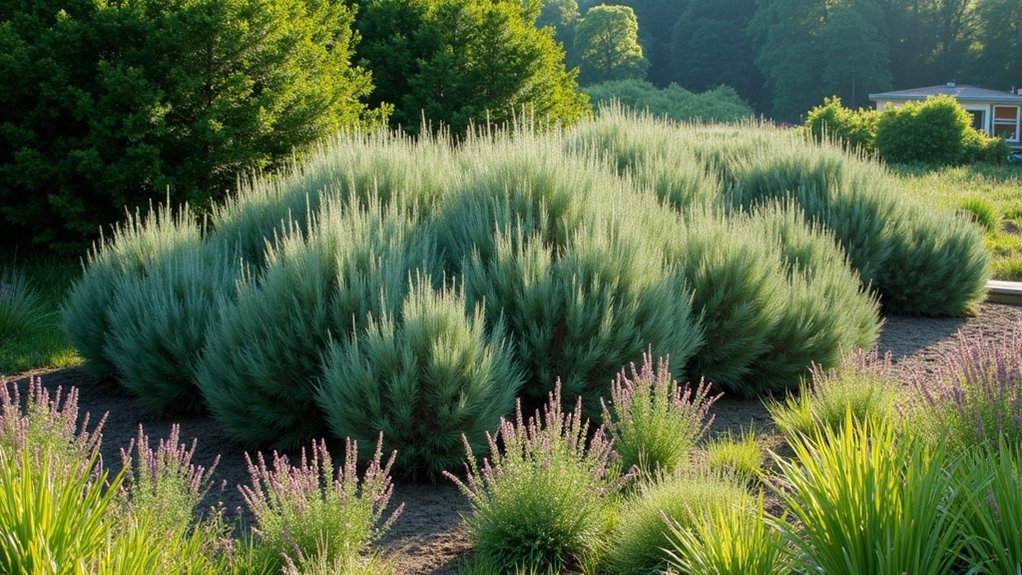
While many plants fall victim to hungry deer, junipers stand as resilient guardians of your landscape. These deer-resistant plants contain volatile oils in their needles that naturally repel wildlife while simultaneously helping them withstand dry spells, making them exceptionally drought tolerant.
You’ll find junipers incredibly versatile for windbreak purposes, with some varieties soaring to 100 feet tall and spreading 25 feet wide. This substantial growth creates effective barriers against harsh winds while adding year-round greenery to your property.
Thriving in full sun and hardy across zones 3-7, junipers adapt well to diverse climates. Their minimal maintenance requirements and resistance to common pests guarantee your windbreak will remain effective for years, combining practical protection with aesthetic appeal in your landscape design.
Russian Sage: Fragrant Perimeter Protection
Beyond the towering presence of junipers, Russian sage offers a complementary approach to deer-resistant windbreaks. This drought-tolerant perennial thrives where other plants struggle, creating an aromatic barrier that deer actively avoid. You’ll appreciate its silvery foliage and stunning amethyst blooms that persist from summer through fall.
Consider these benefits when adding Russian sage to your windbreak design:
- Reaches 2-4 feet tall with an upright habit that effectively disrupts wind patterns.
- Requires minimal maintenance once established in poor soil conditions.
- Provides fragrant perimeter protection through strongly-scented foliage deer find unappealing.
- Attracts beneficial pollinators while maintaining its deer resistant qualities.
For maximum effectiveness, plant Russian sage in full sun areas where you need beautiful, practical protection against both wind and browsing wildlife.
Boxwood: Versatile and Sculpt-able Barriers
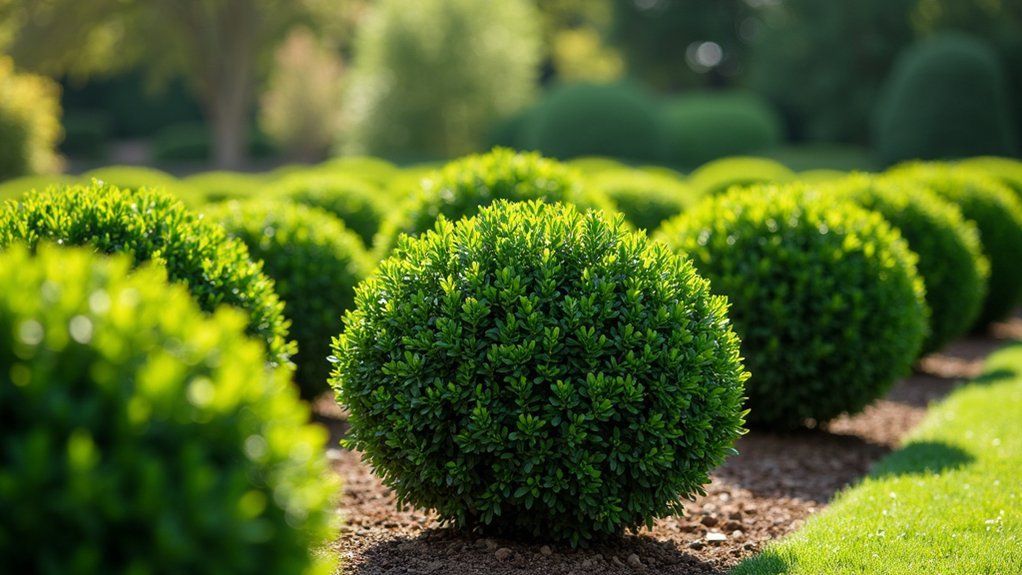
Gardeners treasure boxwood shrubs for their remarkable versatility in creating structured, deer-resistant windbreaks. Their dense foliage and strong scent naturally repel hungry deer, making them an ideal natural barrier for your property’s perimeter.
You’ll appreciate boxwood’s adaptability to different light conditions, thriving in partial to dappled shade across USDA zones 4-8.
With height potential ranging from 1 to 20 feet and width spanning 2 to 8 feet, you can tailor these evergreens to suit specific privacy and windbreak needs.
Boxwoods offer remarkable size flexibility, allowing customized solutions for any landscape’s privacy and wind protection requirements.
Beyond protection from wind and deer, your boxwood barriers will support local wildlife by providing cover for birds and small animals.
Their sculptability allows you to create formal hedges that serve multiple purposes—defending against deer intrusions while adding architectural structure to your landscape design.
Spirea: Year-Round Wind Defense With Seasonal Color
Spirea’s dense growth habit offers you reliable wind protection while its seasonal color shifts from vibrant spring blooms to rich autumn foliage.
You’ll find its natural resistance to deer particularly valuable in rural or woodland-adjacent properties where browsing animals regularly destroy less hardy windbreak options.
Choose from compact varieties like ‘Little Princess’ for low borders or taller cultivars such as ‘Bridal Wreath’ when you need more substantial wind barriers that won’t sacrifice beauty for functionality.
Deer-Resistant Seasonal Changes
When designing a landscape that stands up to both deer and weather challenges, Spirea emerges as an exceptional choice for windbreaks that deliver year-round protection with bonus seasonal appeal.
This versatile shrub offers impressive deer-resistant qualities while creating effective barriers against wind.
- Double Play® Candy Corn® and other cultivars showcase dramatic seasonal color changes, shifting from spring blooms to vibrant summer and fall foliage.
- The finely-textured foliage naturally deters deer browsing, maintaining the integrity of your windbreak throughout growing seasons.
- With heights ranging from 1-8 feet, you’ll find options perfect for layered windbreaks that combine functionality with beauty.
- Hardy in zones 3-8, Spirea thrives in full sun locations where many other deer-resistant plants might struggle.
You’ll appreciate how these low-maintenance shrubs provide continuous wind protection while adding spectacular seasonal color to your landscape.
Windbreak Growth Patterns
As windbreak plants mature, Spirea develops distinctive growth patterns that make it exceptionally effective at blocking wind year-round. Growing from 1 to 8 feet tall, you’ll find a variety perfect for your garden’s scale, whether you need a low barrier or substantial windbreak.
These deer resistant shrubs thrive in USDA zones 3-8 and require full sun to maintain their dense structure.
What makes Spirea exceptional is its finely textured foliage that deer typically avoid, combined with seasonal pink or white blooms that add visual interest to your protective barrier.
You can enhance your windbreak’s effectiveness through strategic pruning, which encourages denser growth while maintaining the plant’s natural shape.
This versatility allows you to create customized protection that serves both functional and aesthetic purposes in your landscape.
Colorful Protective Varieties
Selecting the right spirea cultivar lets you combine exceptional wind protection with stunning seasonal color displays in your deer-resistant windbreak.
These versatile shrubs thrive in zones 3-8 and perform best in full sun, where they’ll develop denser growth for maximum wind deflection.
- Spring-Blooming Options – Many spirea varieties burst with white flowers early in the season while forming an effective windbreak barrier.
- Summer Color Performers – Choose pink or red-flowering cultivars that bloom later for extended seasonal interest.
- Foliage Specialists – Double Play® Candy Corn® offers changing foliage colors throughout the season for year-round visual impact.
- Size Flexibility – Select from various heights and spreads to create custom deer-resistant windbreaks for specific landscape needs.
Spirea’s finely textured foliage naturally deters deer while its dense growth pattern provides consistent wind protection in your landscape.
Butterfly Bush: Wildlife-Friendly Boundary Barriers
Though often overlooked for windbreak designs, butterfly bushes (Buddleja) offer an exceptional combination of deer resistance and ecological benefits. Their strong scent naturally deters deer while creating a vibrant haven for beneficial pollinators in your landscape.
Butterfly bushes create deer-resistant windbreaks while transforming your garden into a pollinator paradise.
You’ll appreciate how these versatile plants bloom continuously from summer until frost, displaying stunning purple, pink, or white flowers that enhance your property’s aesthetic appeal.
Reaching heights between 18 inches and 7 feet, butterfly bushes create effective natural barriers against wind while requiring minimal maintenance.
Plant them in full sun locations for peak growth. Once established, they’ll thrive with little water, making them perfect for various garden conditions.
Ornamental Grasses: Flexible Movement With Strong Roots
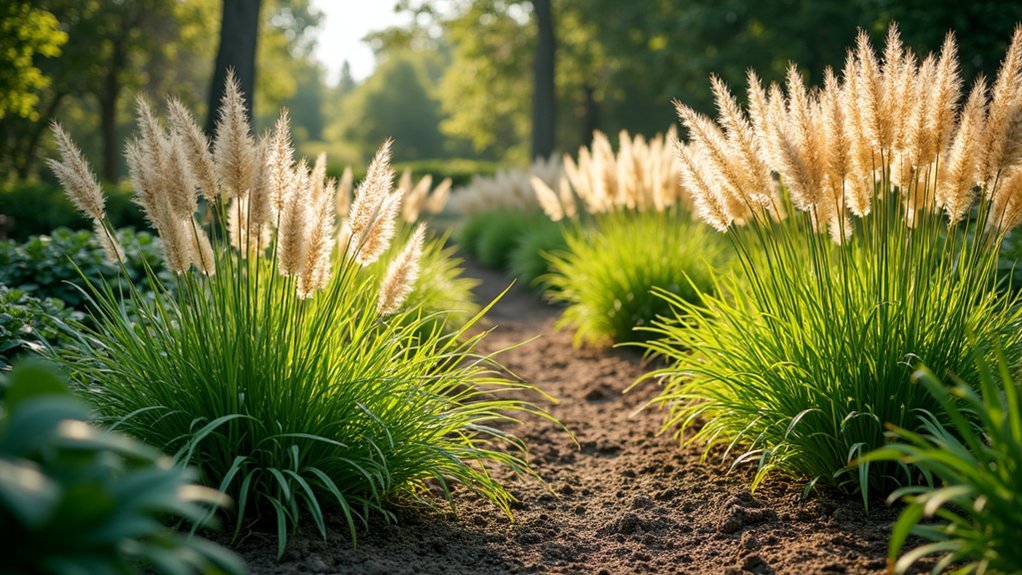
You’ll appreciate how ornamental grasses dance in the wind while maintaining structural strength, creating natural windbreaks that deer typically avoid.
Their extensive root systems anchor firmly into the soil, preventing erosion even during harsh weather conditions.
These resilient plants bend rather than break when faced with strong gusts, making them an ideal year-round barrier that requires minimal maintenance.
Natural Movement Benefits
When designing deer-proof windbreaks, ornamental grasses offer exceptional resilience through their natural movement capabilities. Unlike rigid plants that snap under pressure, deer-resistant varieties like Miscanthus and Panicum dance with the wind, their flexible stems bending rather than breaking during storms. This natural movement creates a dynamic, self-preserving barrier that withstands harsh conditions.
- Wind adaptation – Grasses’ ability to sway dissipates wind energy instead of fighting against it.
- Soil stabilization – Strong root systems prevent erosion while improving soil health.
- Drought tolerance – Established ornamental grasses require minimal watering, creating low-maintenance windbreaks.
- Wildlife benefits – While deterring deer, these grasses attract beneficial birds and pollinators.
You’ll enjoy year-round protection with seasonal visual interest as these grasses change colors and textures throughout different seasons.
Weather-Resistant Foundation
Three key structural advantages make ornamental grasses the ideal weather-resistant foundation for deer-proof windbreaks. Their extensive root systems anchor soil firmly, preventing erosion even in harsh conditions. You’ll find these deer-resistant varieties thrive in challenging environments where other plants struggle.
| Grass Variety | Wind Resistance | Deer Resistance |
|---|---|---|
| Miscanthus | Excellent | High |
| Calamagrostis | Very Good | Very High |
| Panicum | Good | High |
| Schizachyrium | Excellent | Very High |
| Festuca | Good | High |
Once established, these ornamental grasses require minimal maintenance while providing maximum protection. Their flexible stems bend rather than break during storms, creating resilient windbreaks that recover quickly. You’ll appreciate how these adaptable plants maintain their structural integrity across multiple USDA zones, offering year-round protection and wildlife habitat without becoming deer dinner.
Evergreen Barberry: Thorny Protection in Harsh Conditions
Nature’s armor makes Evergreen barberry an excellent choice for windbreaks in deer-populated areas. This hardy shrub combines thorny foliage with year-round coverage, creating a dense barrier that effectively blocks harsh winds while deterring hungry deer.
You’ll appreciate its versatility in challenging environments where other plants might struggle.
- Height advantage – Growing 3-6 feet tall with a 2-4 foot spread, creating a substantial deer-resistant barrier
- Soil flexibility – Thrives in various soil types and tolerates drought conditions
- Four-season protection – Maintains its structure and windbreak functionality throughout the year
- Low maintenance – Requires minimal care once established while providing continuous thorny protection
This resilient shrub offers practical protection without sacrificing your landscape’s aesthetic appeal, making it an ideal windbreak solution.
Deer-Resistant Conifers for Tall Wind Blockades

You’ll find that towering conifers like Colorado Blue Spruce and Eastern Red Cedar create effective windbreaks while naturally deterring hungry deer.
Norway Spruce and White Pine offer substantial wind protection, reaching impressive heights of 50-80 feet while their distinctive textures and scents keep deer at bay.
These majestic evergreens work best when planted in groups, forming a living barrier that combines practical wind resistance with natural deer deterrence.
Towering Deer-Deterrent Evergreens
When establishing effective windbreaks that deer won’t devour, towering conifers offer an ideal solution for both problems.
These deer-resistant giants create substantial barriers against harsh winds while their aromatic oils and needle structure naturally repel hungry deer.
For maximum protection, consider these towering deer-deterrent conifers:
- Colorado Blue Spruce and Eastern Red Cedar – Dense foliage creates effective windbreaks with strong scents deer avoid.
- Thuja Green Giant – Reaches 50-60 feet quickly and deters deer with its aromatic properties.
- White Pine – Grows up to 80 feet while providing wildlife habitat and wind protection.
- Western Red Cedar – Produces natural deer-repelling oils while forming a dense barrier.
For best results, plant these evergreens in staggered rows to enhance wind resistance and create a multi-layered defense against browsing deer.
Scent-Based Needle Varieties
Beyond their impressive height and density, certain conifers offer an additional defensive feature through their aromatic properties.
These deer-resistant conifers release volatile oils that naturally repel browsing animals while creating effective windbreaks for your property.
Eastern and Western Red Cedar varieties provide exceptional wind protection with their dense growth patterns.
Their fragrant foliage contains compounds deer typically avoid, making them practical dual-purpose options.
For striking visual appeal, consider Colorado Blue Spruce, which deters deer while adding a distinctive blue-silver color to your landscape.
Norway Spruce serves as another excellent choice, combining fast growth with aromatic needles that discourage deer browsing.
When planning your windbreak, these scent-based options allow you to create functional boundaries without sacrificing your landscape to hungry wildlife.
Layering Techniques for Maximum Wind Reduction
Creating an effective deer-proof windbreak requires strategic layering of plants at various heights, much like building a natural fortress against the elements.
By combining tall trees, medium shrubs, and low-growing perennials, you’ll achieve maximum wind reduction while keeping deer at bay.
For ideal protection, plant your windbreak 5-10 times the height of your tallest trees from the area you’re sheltering.
Your layering strategy should include:
- Outer layer – Tall evergreens like Colorado Blue Spruce (50+ feet) as your primary wind barrier
- Middle layer – Medium deer-resistant plants such as fragrant Boxwood or Juniper (3-20 feet)
- Inner layer – Low-growing perennials like Bee Balm and Catmint for soil stabilization
- Spacing consideration – Allow adequate room between plants for mature growth while maintaining density
Native Alternatives for Region-Specific Windbreaks
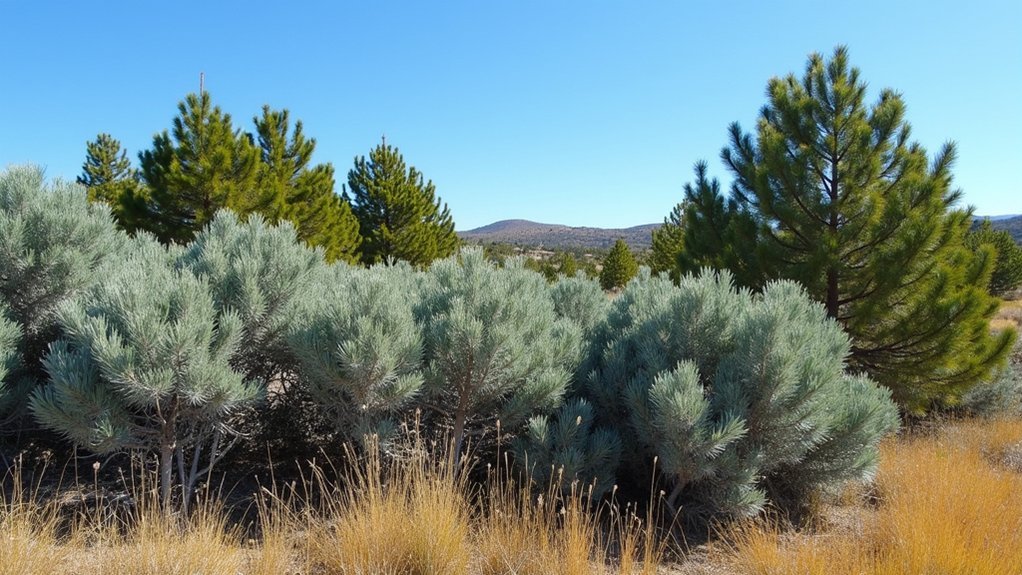
Although generic windbreak recommendations work in many areas, embracing native plants specific to your region dramatically improves both effectiveness and sustainability. Native plants like Eastern Red Cedar and American Holly offer superior deer resistance while thriving in local soil conditions without extra care.
| Region | Deer-Resistant Tree | Native Shrub Option |
|---|---|---|
| Northeast | Eastern Red Cedar | Winterberry |
| Midwest | Silver Maple | Spicebush |
| Southeast | American Holly | Beautyberry |
| West | Rocky Mountain Juniper | Serviceberry |
When designing your windbreak, combine tall native trees with mid-height shrubs and deer-resistant perennials like Bee Balm. This layering creates a complete barrier while supporting local wildlife. Big Bluestem grass makes an excellent addition, stabilizing soil and naturally repelling deer with its coarse texture. These native plants create windbreaks that protect your property and enhance local ecosystems.
Frequently Asked Questions
What Plants Do Deer Hate the Most?
You’ll find deer hate plants with strong scents like marigolds and lavender, fuzzy-textured foliage such as lamb’s ears, bitter herbs including rosemary and sage, and toxic varieties like monkshood and yarrow.
Are There Any Flowers That Deer and Rabbits Won’t Eat?
Yes, you’ll find deer and rabbits avoid flowers with strong scents like Floss Flower, Signet Marigold, and Bee Balm. They’ll also stay away from Lavender, Snapdragons, and Russian Sage due to their unpalatable properties.
What Is the Best Natural Deer Repellent?
You’ll find aromatic plants like lavender and sage work best as natural deer repellents. Homemade sprays using garlic and cayenne pepper are also effective, as deer’s sensitive noses can’t tolerate these strong scents.
What Smell Do Deer Hate?
Deer hate strong smells like garlic, onion, lavender, mint, and rosemary. You’ll find they’re repelled by marigolds’ citrusy scent, aromatic herbs, and the volatile oils in juniper and evergreens.
In Summary
You’ll find that strategic planting of these deer-resistant windbreaks offers multiple benefits beyond just blocking wind. They’ll protect your garden, increase privacy, reduce energy costs, and create habitat for beneficial wildlife. By selecting species suited to your region and using proper layering techniques, you’re creating a natural, sustainable solution that won’t become deer fodder. Consider these options for a windbreak that’s both functional and beautiful.

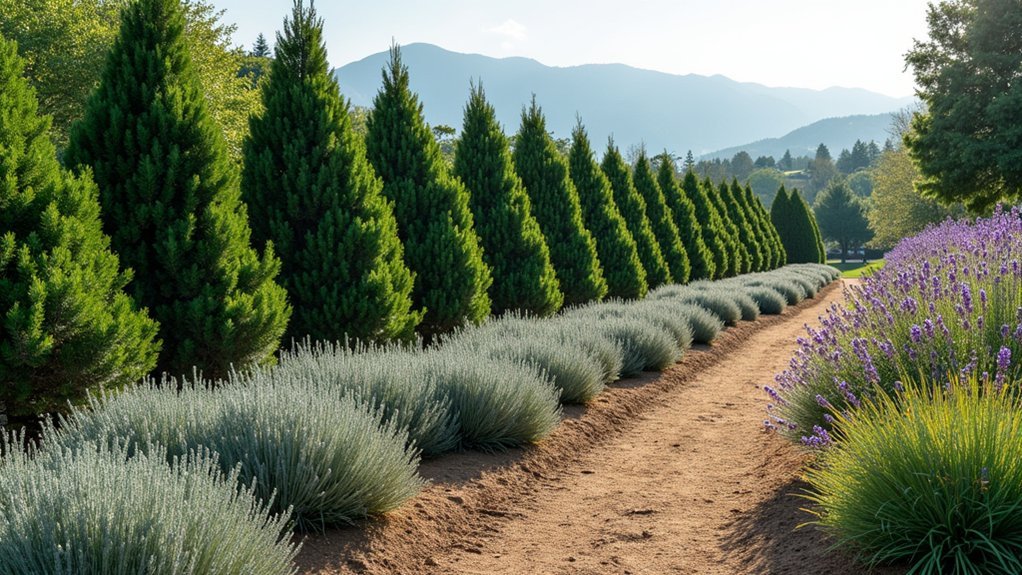



Leave a Reply